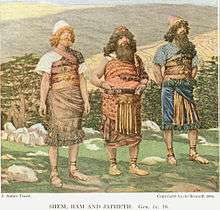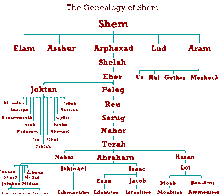Shem
| Shem | |
|---|---|
 Shem, son of Noah | |
| Born |
1557 AM 2568 BCE (date disputed)[note 1] |
| Children |
Elam Asshur Arphaxad Lud Aram |
| Parent(s) | Noah |

Shem (/ʃɛm/; Hebrew: שֵׁם, Modern Shem, Tiberian Šēm; Greek: Σήμ Sēm; Ge'ez: ሴም, Sēm; "renown; prosperity; name"; Arabic: سام Sām) was one of the sons of Noah in the Hebrew Bible as well as in Islamic literature. Genesis 10:21 refers to relative ages of Shem and his brother Japheth, but with sufficient ambiguity to have yielded different English translations. The verse is translated in the KJV as "Unto Shem also, the father of all the children of Eber, the brother of Japheth the elder, even to him were children born.". However, the New American Standard Bible gives, "Also to Shem, the father of all the children of Eber, and the older brother of Japheth, children were born."
Genesis 11:10 records that Shem was 100 years old at the birth of Arphaxad, two years after the flood; and that he lived for another 500 years after this, making his age at death 600 years.
The children of Shem were Elam, Asshur, Arphaxad, Lud and Aram, in addition to daughters. Abraham, the patriarch of the Hebrews and Arabs, was one of the descendants of Arphaxad.
Islamic literature describes Shem as one of the believing sons of Noah. Some sources even identify Shem as a prophet in his own right and that he was the next prophet after his father.[1] In one Muslim legend, Shem was one of the people that God made Jesus resurrect as a sign to the Children of Israel.[2]
The 1st-century historian Flavius Josephus, among many others, recounted the tradition that these five sons were the progenitors of the nations of Elam, Assyria, Chaldea, Lydia, and Levantine, respectively.
The associated term Semitic is still a commonly used term for the Semitic languages, as a subset of the Afro-Asiatic languages, denoting the common linguistic heritage of Arabic, Aramaic, Akkadian, Ethiopic, Hebrew and Canaanite-Phoenician languages.
According to some Jewish traditions (e.g., B. Talmud Nedarim 32b; Genesis Rabbah 46:7; Genesis Rabbah 56:10; Leviticus Rabbah 25:6; Numbers Rabbah 4:8.), Shem is believed to have been Melchizedek, King of Salem whom Abraham is recorded to have met after the battle of the four kings.
Shem is mentioned in Genesis 5:32, 6:10; 7:13; 9:18,23,26-27; 10; 11:10; also in 1 Chronicles 1:4.


Descendants
Genesis 10
According to Genesis 10:22-31
22 The children of Shem: Elam, and Asshur, and Arphaxad and Lud and Aram.
23 And the children of Aram; Uz and Hul, and Gether and Mash.
24 And Arphaxad begat Salah and Salah begat Eber.
25 And unto Eber were born two sons: the name of one [was] Peleg; for in his days was the earth divided;
and his brother's name [was] Joktan.
26 And Joktan begat Almodad, and Sheleph, and Hazarmaveth, and Jerah.
27 And Hadoram, and Uzal and Diklah,
28 And Obal, and Abimael and Sheba,
29 And Ophir, and Havilah, and Jobab: all these were the sons of Joktan.
30 And their dwelling was from Mesha, as thou goest unto Sephar a mount of the east
31 These [are] the sons of Shem, after their families, after their tongues, in their lands, after their nations.
Genesis 11
Excerpts from Genesis 11:10-26—
Shem [was] an hundred years old, and begat Arphaxad two years after the flood ...
Arphaxad lived five and thirty years, and begat Salah ...
Salah lived thirty years, and begat Eber ...
Eber lived four and thirty years, and begat Peleg ...
Peleg lived thirty years, and begat Reu ...
Reu lived two and thirty years, and begat Serug ...
Serug lived thirty years, and begat Nahor ...
Nahor lived nine and twenty years, and begat Terah ...
Terah lived seventy years, and begat Abram, Nahor, and Haran ... and Haran begat Lot
Book of Jasher
A rabbinic document that surfaced in the 17th century, claiming to be the lost Book of Jasher provides some names not found in any other source. Some have reconstructed more complete genealogies based on this information as follows:
Shem. Also Sem Literal meanings are named or renown (father of the Semitic races - Shemites). The sons of Shem were:
- Elam "eternity" (sons were Shushan, Machul and Harmon)[3] - (Elamites and Khuzestanis)[4]
- Asshur "a step" or "strong" (sons were Mirus and Mokil)[5] - (Assyrians)
- Arphaxad (sons were Shelach, Anar and Ashcol)[5] - Chaldeans, Hebrews (Israelites, Moabites, Ammonites, Edomites, Ishmaelites, and Qahtanites)
- Ziezi - son of Shem and a grandson of Noah. His name is mentioned in the excerpt Ziezi ex quo vulgares meaning "Ziezi, of whom the Bulgars" but being regarded by some as the first European reference to the Bulgars as a people. (Bulgars and Thracians—though modern scholarship classifies neither as Semitic; the former being Turkic and the latter Indo-European)
- Lud "strife" (sons were Pethor and Bizayon)[6] - (Ludim, Lubim, Ludians, Ludu, Lydians, and other related groups in Asia Minor—generally classified today as Indo-European).
- Aram "exalted" (sons were Uz, Chul, Gather and Mash)[6] - (Aramaeans).
Book of Luke
According to Luke 3:36 Jesus is a descendant of Shem.
Family tree
See also
Footnotes
Notes
- ↑ The 1557 Anno Mundi birthdate for Shem is based on the standard Masoretic text as represented in the Authorized Version. Septuagint and Samaritan texts have different values. See Chronology of the Bible.
References
- ↑ Historical Dictionary of Prophets in Islam and Judaism, Wheeler, Shem
- ↑ Stories of the Prophets, Ibn Kathir, Story of Jesus
- ↑ Parry, J. H. (ed.). "7:15". Book of Jasher. Translated by Moses, Samuel.
- ↑ "The Table of Nations: Ham, Shem and Japheth, Sons of Noah - Courtesy of Return To Glory". Freemaninstitute.com. Retrieved 2013-12-17.
- 1 2 Parry, J. H. (ed.). "7:16". Book of Jasher. Translated by Moses, Samuel.
- 1 2 Parry, J. H. (ed.). "7:17". Book of Jasher. Translated by Moses, Samuel.
External links
| Look up Shem in Wiktionary, the free dictionary. |
-
 Herbermann, Charles, ed. (1913). "Sem (Shem)". Catholic Encyclopedia. New York: Robert Appleton Company.
Herbermann, Charles, ed. (1913). "Sem (Shem)". Catholic Encyclopedia. New York: Robert Appleton Company.